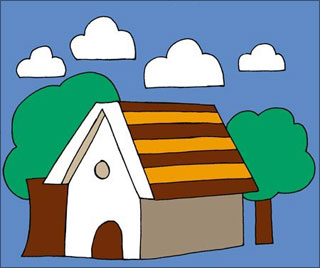 | « Back to article | Print this article |
Low-cost housing? Here come new lenders!
Three years ago, at the height of the economic boom, the Rs 10-lakh (Rs 1 million) housing segment hardly had developers, leave alone financiers.
Now, there are at least 25 property developers constructing houses in the Rs 3-7 lakh (Rs 300,000-700,000) segment.
Consequently, a new crop of lending agencies like Dewan Housing Finance, Gruh Finance, Micro House Finance Corporation, SEWA and Mahindra Rural Housing Finance have entered the market.
With another 50,000 units, priced up to Rs 10 lakh, expected to be sold this year, as estimated in a study conducted by Monitor Inclusive Markets, at least a dozen lenders are looking to enter the segment, exclusively to cater to the sub Rs 10-lakh market.
Click NEXT to read on . . .
Low-cost housing? Here come new lenders!
According to a study by the National Housing Bank, SUMEL Housing Finance, Aptus Value Housing Finance India, Home First Finance and Aadhar Housing Finance are among the players that have sought or received a certificate of registration (CoR) from NHB.
The other possible entrants include Muthoot Pappacham Group, Equitas and Grameen Koota. NHB Executive Director R V Verma said there were another half-a-dozen players who had contacted the refinance-cum-regulatory body for housing finance.
While the study stated that a possible shortfall of loans for the low-income segment in urban India might stay for the next 12-24 months, NHB has itself initiated steps to bridge the deficit.
To start with, it plans to provide monetary support to nearly two dozen microfinance institutions and housing finance companies, besides granting them an early refinance facility.
Click NEXT to read on . . .
Low-cost housing? Here come new lenders!
Housing finance companies are eligible for refinance after three years, but in case of lending agencies catering to the low-income segment, the plan is to provide refinance from the first year itself.
Besides, NHB has been helping these lending institutions with capacity building. "In many cases, in the low-income segment, the borrower does not have a proper salary slip. We are helping the lender to assess the financial capacity of such borrowers so that they can be given loans," said Verma.
The other problem has been lack of builders for the low-income segment. To ensure sufficient availability of low-income dwelling units, NHB also plans to provide equity support to developers. A final decision on the issue will, however, be taken by the NHB board.
"There were supply-side (absence of low-cost homes) as well as demand-side (lack of finance) issues. We are trying to address both the problems," Verma said.
Click NEXT to read on . . .
Low-cost housing? Here come new lenders!
The study by Monitor shows that almost 25 developers are building low-income multi-family units in urban areas.
Most of these houses are typically one-two bedroom units built in 350-700 sq ft. Mumbai and Ahmedabad are witnessing highest activity, followed by Pune, Chennai, Nagpur, Bengaluru and Meerut.
"Most of these low-cost houses are coming up slightly away from cities, where land prices are significantly lower and the cost of construction is comparatively less. Developers entering this segment are compromising on profits, as they realise that it's a volume game," says Jones Lang LeSalle Meghraj CEO (Operations) Shantosh Kumar.
"Low-cost housing is approaching scale through geographic expansion by national and regional players, and subsequent replication by local players. In 2010-11, an estimated 25,000-50,000 houses will be on sale in the market," the study said.
Click NEXT to read on . . .
Low-cost housing? Here come new lenders!
"Moreover, given the plans and projections of the new breed of developers (especially larger ones like Value and Budget Housing Corporation, Neptune, Foliage and Tata Group), this number should increase exponentially in the near future," added the study.
Value and Budget Housing Corporation (VBHC), promoted by Jaithirth Rao, is looking to build close to a million low-cost houses over the next 10 years. "There are few companies looking at the segment that offers entry-level affordable housing solutions. We saw this as an opportunity and set up VBHC," says Rao.
"In our model, land is not a capital asset but a current asset. We call this 'manufacturing' business, where more the scale, more the earnings," said VBHC managing director and CEO P S Jayakumar.
Low-cost husing is going to be a profitable venture for lenders as well as builders, says a company official. For VBHC, Jayakumar says, the margin will be 25 per cent.





